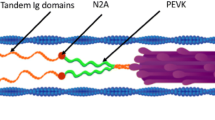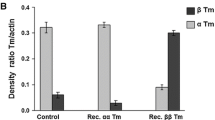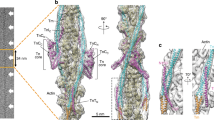Abstract
Hodges and his colleagues identified a 12 amino acid fragment of troponin I (TnI-ip) that inhibits Ca2+-activated force and reduces the effectiveness Ca2+ as an activator. To understand the role of troponin C (TnC) in the extended cooperative interactions of thin filament activation, we compared the effect of TnI-ip with that of partial troponin TnC extraction. Both methods reduce maximal Ca2+-activated force and increase [Ca2+] required for activation. In contrast to TnC extraction, TnI-ip does not reduce the extended cooperative interactions between adjacent thin filament regulatory units as assessed by the slope of the pCa/force relationship. Additional evidence that TnI-ip does not interfere with extended cooperativity comes from studies that activate muscle by rigor crossbridges (RXBs). TnI-ip increases both the cooperativity of activation and the concentration of RXBs needed for maximal force. This shows that TnI-ip binding to TnC increases the stability of the relaxed state of the thin filament. TnI-ip, therefore, uncouples force generation from extended cooperativity in both Ca2+ and RXB activated muscle contraction. Because maximum force can be reduced with no change—or even an increase—in cooperativity, force-generating crossbridges do not appear to be the primary activators of cooperativity between thin filament regulatory units of skeletal muscle.




Similar content being viewed by others
Notes
The decrease in cooperativity is calculated assuming unlinked regulatory units would exhibit Hill coefficients of about 1.4 because of the interaction between Ca2+ binding loops I and II (Zot et al. 1986). Experimental results and theoretical analysis suggests that the value may lie between 1.4 and 2.
References
Allen TS, Yates LD, Gordon AM (1992) Ca(2+)-dependence of structural changes in troponin-C in demembranated fibers of rabbit psoas muscle. Biophys J 61(2):399–409
Brandt PW, Schachat FH (1997) Troponin C modulates the activation of thin filaments by rigor cross- bridges. Biophys J 72(5):2262–2267
Brandt PW, Reuben JP, Grundfest H (1972) Regulation of tension in the skinned crayfish muscle fiber. II. Role of calcium. J Gen Physiol 59(3):305–317
Brandt PW, Cox RN, Kawai M (1980) Can the binding of Ca2+ to two regulatory sites on troponin-C determine the steep pCa/tension relationship of skeletal muscle? Proc Natl Acad Sci USA 77:4717–4720
Brandt PW, Cox RN, Kawai M, Robinson T (1982) Regulation of tension in skinned muscle fibers: effect of cross-bridge kinetics on apparent Ca2+ sensitivity. J Gen Physiol 79:997–1016
Brandt PW, Diamond MS, Gluck B, Kawai M, Schachat F (1984a) Molecular basis of cooperativity in vertebrate muscle thin filaments. Carlsberg Res Commun 49:l55–l67
Brandt PW, Diamond MS, Schachat FH (1984b) The thin filament of vertebrate skeletal muscle co-operatively activates as a unit. J Mol Biol 180(2):379–384
Brandt PW, Gluck B, Mini M, Cerri C (1985) Hysteresis of the mammalian pCa/tension relation is small and muscle specific. J Muscle Res Cell Motil 6:197–205
Brandt PW, Diamond MS, Rutchik JS, Schachat FH (1987) Co-operative interactions between troponin-tropomyosin units extend the length of the thin filament in skeletal muscle. J Mol Biol 195(4):885–896
Brandt PW, Roemer D, Schachat FH (1990) Co-operative activation of skeletal muscle thin filaments by rigor crossbridges. The effect of troponin C extraction. J Mol Biol 212(3):473–480
Brandt PW, Colomo F, Piroddi N, Poggesi C, Tesi C (1998) Force regulation by Ca2+ in skinned single cardiac myocytes of frog. Biophys J 74(4):1994–2004
Bremel RD, Weber A (1972) Cooperation within actin filament in vertebrate skeletal muscle. Nat New Biol 238:97–101
Briggs MM, Brandt PW, Schnurr CA, Schachat FH (1989) Two alternative splicing events that generate functionally different fast troponin T isoforms. Cellular and molecular biology of muscle development. Liss, New York, pp 597–605
Changeux JP, Edelstein SJ (2005) Allosteric mechanisms of signal transduction. Science 308(5727):1424–1428
Eastwood AB, Wood DS, Bock KL, Sorenson MM (1979) Chemically skinned mammalian skeletal muscle. I. The structure of skinned rabbit psoas. Tissue Cell 11:553–566
Guth K, Potter JD (1987) Effect of rigor and cycling cross-bridges on the structure of troponin C and on the Ca2+ affinity of the Ca2+-specific regulatory sites in skinned rabbit psoas fibers. J Biol Chem 262(28):13627–13635
Huang M, Burkhoff D, Schachat F, Brandt PW (2001) Fluorescence changes on contractile activation in TnC(DANZ) labeled skinned rabbit psoas fibers. J Muscle Res Cell Motil 22(8):635–646
Karlin A (1967) On the application of “a plausible model” of allosteric proteins to the receptor for acetylcholine. J Theor Biol 16(2):306–320
Lu Z, Swartz DR, Metzger JM, Moss RL, Walker JW (2001) Regulation of force development studied by photolysis of caged ADP in rabbit skinned psoas fibers. Biophys J 81(1):334–344
McKillop DF, Geeves MA (1993) Regulation of the interaction between actin and myosin subfragment 1: evidence for three states of the thin filament. Biophys J 65(2):693–701
Monod J, Wyman J, Changeux JP (1965) On the nature of allosteric transitions: a plausible model. J Mol Biol 12:88–118
Moss RL (1992) Ca2+ regulation of mechanical properties of striated muscle. Mechanistic studies using extraction and replacement of regulatory proteins. Circ Res 70(5):865–884
Moss RL, Swinford AE, Greaser ML (1983) Alterations in the Ca2+ sensitivity of tension development by single skeletal muscle fibers at stretched lengths. Biophys J 43(1):115–119
Moss RL, Giulian GG, Greaser ML (1985) The effects of partial extraction of TnC upon the tension-pCa relationship in rabbit skinned skeletal muscle fibers. J Gen Physiol 86(4):585–600
Regnier M, Rivera AJ, Wang CK, Bates MA, Chase PB, Gordon AM (2002) Thin filament near-neighbour regulatory unit interactions affect rabbit skeletal muscle steady-state force-Ca(2+) relations. J Physiol 540(Pt 2):485–497
Reuben JP, Brandt PW, Berman M, Grundfest H (1971) Regulation of tension in the skinned crayfish muscle fiber. I. Contraction and relaxation in the absence of Ca (pCa is greater than 9). J Gen Physiol 57(4):385–407
Rüegg JC, Zeugner C, Van Eyk J, Kay CM, Hodges RS (1989) Inhibition of TnI-TnC interaction and contraction of skinned muscle fibres by the synthetic peptide TnI [104–115]. Pflugers Arch 414(4):430–436
Schachat FH, Bronson DD, McDonald OB (1985) Heterogeneity of contractile proteins. A continuum of troponin-tropomyosin expression in mammalian skeletal muscle. J Biol Chem 260(2):1108–1113
Schachat FH, Briggs MM, Williamson EK, McGinnis WH, Diamond MS, Brandt PW (1989) Expression of fast thin filament proteins defining fiber archetypes in a molecular continuum. In: Pette D (ed) Dynamic state of muscle fibers. Walter De Gruiter, New York, pp 279–291
Smith DA, Geeves MA (2003) Cooperative regulation of myosin-actin interactions by a continuous flexible chain II: actin-tropomyosin-troponin and regulation by calcium. Biophys J 84(5):3168–3180
Smith DA, Maytum R, Geeves MA (2003) Cooperative regulation of myosin-actin interactions by a continuous flexible chain I: actin-tropomyosin systems. Biophys J 84(5):3155–3167
Strauss JD, Van Eyk JE, Barth Z, Kluwe L, Wiesner RJ, Maeda K, Rüegg JC (1996) Recombinant troponin I substitution and calcium responsiveness in skinned cardiac muscle. Pflugers Arch 431(6):853–862
Sun YB, Irving M (2010) The molecular basis of the steep force-calcium relation in heart muscle. J Mol Cell Cardiol 48(5):859–865
Swartz DR, Moss RL (1992) Influence of a strong-binding myosin analogue on calcium-sensitive mechanical properties of skinned skeletal muscle fibers. J Biol Chem 267(28):20497–20506
Swartz DR, Moss RL, Greaser ML (1997) Characteristics of troponin C binding to the myofibrillar thin filament: extraction of troponin C is not random along the length of the thin filament. Biophys J 73(1):293–305
Talbot JA, Hodges RS (1981a) Comparative studies on the inhibitory region of selected species of troponin-I. The use of synthetic peptide analogs to probe structure-function relationships. J Biol Chem 256(23):12374–12378
Talbot JA, Hodges RS (1981b) Synthetic studies on the inhibitory region of rabbit skeletal troponin I. Relationship of amino acid sequence to biological activity. J Biol Chem 256(6):2798–2802
Van Eyk JE, Strauss JD, Hodges RS, Rüegg JC (1993) A synthetic peptide mimics troponin I function in the calcium-dependent regulation of muscle contraction. FEBS Lett 323(3):223–228
Van Eyk JE, Thomas LT, Tripet B, Wiesner RJ, Pearlstone JR, Farah CS, Reinach FC, Hodges RS (1997) Distinct regions of troponin I regulate Ca2+-dependent activation and Ca2+ sensitivity of the acto-S1-TM ATPase activity of the thin filament. J Biol Chem 272(16):10529–10537
Williams DL, Greene LE, Eisenberg E (1988) Cooperative turning on of myosin subfragment 1 adenosinetriphosphatase activity by the troponin-tropomyosin-actin complex. Biochemistry 27(18):6987–6993
Wood DS, Zollman J, Reuben JP, Brandt PW (1975) Human skeletal muscle: properties of the “chemically skinned” fiber. Science 187:187
Xing J, Chinnaraj M, Zhang Z, Cheung HC, Dong WJ (2008) Structural studies of interactions between cardiac troponin I and actin in regulated thin filament using Forster resonance energy transfer. Biochemistry 47(50):13383–13393
Zot HG, Guth K, Potter JD (1986) Fast skeletal muscle skinned fibers and myofibrils reconstituted with N-terminal fluorescent analogues of troponin C. J Biol Chem 261:15883–15890
Acknowledgments
We wish to thank Margaret Briggs for her assistance and comments in preparation of the manuscript, and Dr. Chris Wall for assistance in generating the bivariate fit for Fig. 1. This work was supported by grants from the U.S. National Institutes of Health to PWB (AR40300) and FS (AR39603).
Author information
Authors and Affiliations
Corresponding author
Rights and permissions
About this article
Cite this article
Schachat, F., Brandt, P.W. The troponin I: inhibitory peptide uncouples force generation and the cooperativity of contractile activation in mammalian skeletal muscle. J Muscle Res Cell Motil 34, 83–92 (2013). https://doi.org/10.1007/s10974-013-9336-y
Received:
Accepted:
Published:
Issue Date:
DOI: https://doi.org/10.1007/s10974-013-9336-y




